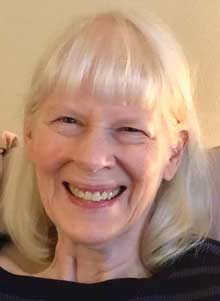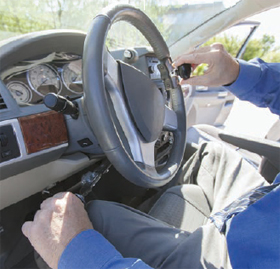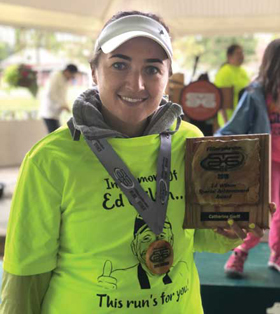Stories to Inspire
Driven to Succeed
By Jo Ann Maxwell
 It all started when my mother was in the hospital. My niece came down from Ohio to see my mother, and she and I walked several times from my mother’s room to the cafeteria. I’m sure you’ve been to a hospital and know how far that might be! Without me present, she mentioned to my mother that I was walking poorly and I should have hand controls in my car. That started conversations within my family that I needed to get hand controls… and needed them quickly.
It all started when my mother was in the hospital. My niece came down from Ohio to see my mother, and she and I walked several times from my mother’s room to the cafeteria. I’m sure you’ve been to a hospital and know how far that might be! Without me present, she mentioned to my mother that I was walking poorly and I should have hand controls in my car. That started conversations within my family that I needed to get hand controls… and needed them quickly.
I’ve known that I would eventually need hand controls, but I got a little upset that all of a sudden my family was pressuring me. I know they only want the best for me and want me to be safe. I guess I just didn’t like the way the conversations started.
One of my good MS friends told me that I was being fearless to admit that I needed the hand controls. That really turned my attitude around! I refuse to let MS take one more thing from me! I knew that ultimately, I would gain independence through the use of hand controls.
I contacted several different organizations for assessment, training, and installation. I learned that there was an occupational therapist driving instructor in my area. I made an appointment for an assessment. I had become determined that it was time for me to make the switch.
I had my first driving training for hand controls a couple of weeks later. It was a little scary. Not only were we having a terrible rainstorm, but while my left hand was operating the brake/accelerator mechanism, my right hand and arm were having trouble with the knob on the steering wheel. We drove for more than an hour and a half, and I got very fatigued. The occupational therapist who was my driving instructor was very concerned. She wondered if I would be able to drive at all.
We tried a different knob configuration for my right hand and arm the next day. It was a disaster, turning out to be much harder than the first one we used. The instructor stopped the driving lesson after five minutes and told me that she would be writing a report to the DMV. I asked her if she thought they would pull my license after they saw that I was not successful with the training. She said they might.
She also mentioned that there could be a right installation of the brake and accelerator mechanism instead of the left. With this configuration, my left hand, which had become my dominant hand, would be on the steering wheel. She said that the dominant hand should be on the steering wheel.
Unfortunately, the local occupational therapist did not have a right-installed brake and accelerator control. The closest certified driving instructor (another occupational therapist) with the kind of controls I needed was about four hours away. I was fortunate to find out that this second occupational therapist would soon be in my area, so she and I did some training… and I was very glad that I didn’t have far to drive for my training!

For an individual who has difficulty operating a car using a standard steering wheel and foot pedals, hand controls may be installed. Shown above is a steering wheel knob on the right and a lever for accelerating and braking on the left.
In the meantime, I received a letter from the DMV saying that they had approved my medical request for specialized equipment in the car. I called them immediately and received an extension, as I needed to practice with the new controls. The person who I talked to stated that I can get an extension with a recommendation from my doctor, which I did.
I had some apprehension about the new configuration of hand controls, as I had already tried several different combinations. I had driven with my feet for 50 years, so my brain was struggling to figure out this new way. But, I had a wonderful session of driver training with the second occupational-driving instructor. We tried several configurations of a right-handed accelerator/brake. There are several ways you can use a hand control for the car. For example, you can push for the brake, and for the accelerator, you can either pull back or twist. The one that worked the best for me was the push and pull. I am also able to rest my arm on the middle console, which helps to keep my fatigue under control.
With my right hand using the hand control to brake and accelerate, my left hand – which is my stronger hand – operated the steering wheel. Using a knob that mounts on the steering wheel, we tried a less-resistant steering wheel, but we found that I had no problems using the regular steering wheel with the special knob.
The next step was to get a new quote from the installation company. I have been very blessed to receive financial assistance from a few charitable organizations. As it happens, the right controls are a little more expensive than left controls.
After 50 years of driving, I finally received my learners permit! The hand controls were installed soon afterward. I had been practicing and practicing. I really had to pay attention, especially when going from reverse to drive or vice versa. The driving test consisted of driving on a state highway, turning onto a main road, going into a quiet neighborhood, performing a three-point turn, and backing up. Then we drove back to the DMV office. The DMV officer said I did well and I passed! Yahoo!
With this new equipment added to my car, I have also found that the extra mirrors really help. Since my two hands are busy working the brake and accelerator, it’s hard to turn and look behind me. There is an added bonus as well – now that I’m driving with my hands, I can wear my ankle-foot orthotic (AFO). I couldn’t drive with it before, so I very rarely used it. Now that I can have it on all the time, I am walking so much better with it!
Even though it took six months, I’m very glad I went through with getting the hand controls for my car. It’s amazing how small changes can make a big difference, and I can still drive independently. I am feeling more and more confident every day!
Our Family Heroine
By Judy Heilpern Eror
 No one was more surprised than I was when my daughter, Catherine Garff, decided to train for the St. George Marathon. Ours is not a running family. We cycle, ski, and swim. We do not run. But Catherine is our family heroine. So she runs.
No one was more surprised than I was when my daughter, Catherine Garff, decided to train for the St. George Marathon. Ours is not a running family. We cycle, ski, and swim. We do not run. But Catherine is our family heroine. So she runs.
More than eight years ago, Catherine was diagnosed with multiple sclerosis. At the time, none of us knew what that meant and all of the books, pamphlets, and lectures that were recommended seemed to be full of gloom and doom. Catherine, however, is not a gloom-and-doom woman. She is amazing.
Sixteen months ago she gave birth to her youngest child – six weeks early. Catherine’s blood pressure (preeclampsia) was 180 over 130. In addition to taking care of her own health issues and recovering from an emergency C-section, the baby came home with a feeding tube and an oxygen tank. If that wasn’t enough, she had three other children to take care of.
Instead of feeling sorry for herself, Catherine started running. She set a goal of running the St. George Marathon – it would be her first marathon. She researched marathon training, diets, and made a plan – putting everything in a spreadsheet. And then she went to work.
Halfway through Catherine’s marathon training this summer, Catherine started battling severe fatigue – a common symptom of the disease. She also began losing the feeling in her face, arms, and legs. When she ran, she would get electric shocks down her legs. She has had MS for more than eight years, but after an MRI, it was found that Catherine’s MS treatment stopped working. She had new lesions on her spine and she was in the middle of an MS relapse.

Catherine Garff was honored to receive the Ed Wilson Special Achievement Award. This award celebrates the people who have achieved personal greatness in their lives. This award has been given to runners and wheelchair participants of all ages and circumstances – those who have gone the extra mile in overcoming adversity in their training and personal lives to run the marathon.
Together with a doctor, she’s started a new treatment and has regained the feeling she lost in her face, arms, and legs. She has also gotten her fatigue under control, but through it all, she kept running. She will run a 13-mile training run in the morning, and go get a medication infusion at the doctor’s office in the afternoon. She’s been on her new treatment plan and it’s working, but what is really impressive to our family is that even while going through her relapse and with all the issues she’s been battling – on top of work, mothering, and typical runners’ ailments – she hasn’t skipped a single training run.
Catherine is more disciplined than any person I know. She has set a healthy meal plan and kept to it. She has run two half-marathons and one full one this year in preparing for St. George. Last week, on a one-day notice, she even flew to New Hampshire to join a running team who found themselves in need of a last-minute substitute.
My daughter is married to a great husband and she supports him in his career and his very active outdoor hobbies too, such as competitive bicycle racing. Catherine is the mother of four children (Daniel age 8, Catherine age 6, Duncan age 4, and Scott age 16 months). She is a successful real estate agent, and with her husband, they own a brokerage together. She has served as the Chairwoman of the board of the Rape Recovery Center. She has been an active volunteer at her children’s school and has also served in her church. She has set an example for everyone around her.
Like I said – in our family, we don’t run – we cheer. And we cheer loudly for the heroine that I am grateful to call my daughter, Catherine Elaine Eror Garff.
